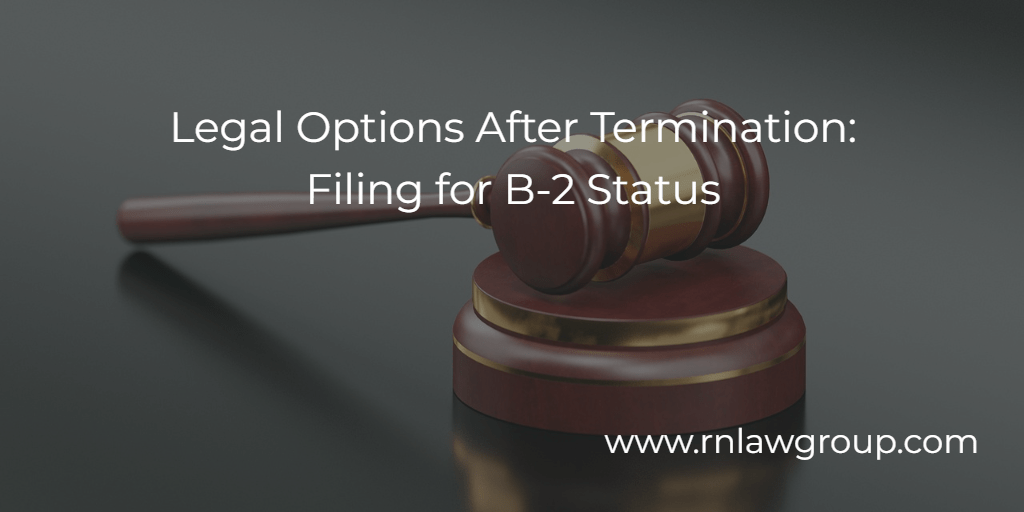
Legal Options After Termination: Filing for B-2 Status
Discovering the right legal avenues after termination is crucial for individuals navigating changes in their immigration status. In this comprehensive guide, we delve into the process of filing for B-2 status post-employment termination. Whether you’re an employer looking to support departing employees or an individual seeking clarity on your immigration options, understanding the intricacies of B-2 status conversion is essential. From eligibility criteria to documentation requirements, we’ll explore the steps involved in securing your legal status and ensuring a smooth transition in uncertain times.
Determining Eligibility: Requirements for Filing B-2 Status After Job Loss
Deciphering eligibility requirements is paramount for individuals seeking to transition to B-2 status subsequent to job loss. To qualify for B-2 status following termination, certain criteria must be met. Most importantly, applicants must be maintaining their current nonimmigrant status. This is typically established with an unexpired I-94 and recent pay statements. Primarily, applicants must demonstrate their intent to visit the United States temporarily for pleasure, tourism, or medical treatment. Additionally, they must prove their ability and intention to depart the country upon the expiration of their authorized stay. While employment termination can introduce complexities, applicants must show sufficient ties to their home country, such as familial, financial, or property connections, to establish their non-immigrant intent. Understanding these essential requirements is fundamental to navigating the process effectively and securing legal status post-employment loss.
Leveraging the 60-Day Grace Period When Transitioning to B-2
Submitting the I-539 application requesting a change of status to B-2 within the designated timeframe is critical for applicants navigating post-employment termination. This application must be diligently prepared and delivered to the United States Citizenship and Immigration Services (USCIS) before the expiration of the 60-day grace period. Timing is of the essence, as failing to file within this window may jeopardize the application’s success. Proper completion and submission of the application, along with adherence to USCIS guidelines, ensure that applicants maximize their opportunity for a smooth transition to B-2 status and legal residency post-termination. Note, that it is not mandatory to receive the I-539 receipt notice before the end of the 60-day grace period. As long as the application is timely and properly filed, even if the receipt notice is delivered after the 60-day grace period has ended, the applicant is still eligible to remain in the United States in a period of authorized stay.
Choosing Your Path: Online vs. Paper Filing for B-2 Status Post-Employment Termination
When deciding between filing online or on paper for B-2 status post-employment termination, it’s essential to weigh the pros and cons of each method. Opting for online filing offers convenience and speed, allowing applicants to submit their forms electronically and receive immediate confirmation of submission. This can be particularly advantageous when nearing the deadline, as online filing ensures timely receipt by USCIS. However, it’s crucial to note that if an attorney is involved in the process, the application must be filed on paper. Additionally, applicants filing online with dependents must submit separate applications for each individual, necessitating payment of filing fees for each person. On the other hand, paper filing may be preferred for those who prefer a tangible record of their submission or for cases involving complex documentation. While paper filing may take longer to process and lacks immediate confirmation, it remains a viable option for those who prioritize thoroughness and precision in their application.
Documenting Your Case: Essential Papers for B-2 Status Application Post-Employment Termination
When applying for a change of status to B-2 after employment termination, assembling the requisite documentation is pivotal to a successful application. Primarily, applicants must include Form I-539, the official application for a change of status, accurately completed and signed and the correct filing fees. Supporting this form, evidence demonstrating financial ability to support oneself during the intended stay in the U.S. is crucial, such as bank statements or affidavits of support. Moreover, applicants must include a copy of their passport bio-page, U.S. visas, I-94, any I-797 approval notices, and recent pay statements to demonstrate maintenance of status. Depending on individual circumstances, supplementary documentation may be required, such as a personal statement detailing the reasons for seeking B-2 status and their intent to comply with visa regulations or proof of ties to the home country, such as property ownership, family connections, or ongoing commitments, to substantiate the temporary nature of the visit.
B-2 Status Duration: How Long Can You Request Post-Employment Termination?
When seeking B-2 status post-employment termination, applicants should be aware that the maximum duration permissible for a single stay is typically 180 days. This timeframe offers individuals ample opportunity to address personal matters, explore tourism, or fulfill medical needs within the United States. Upon filing Form I-539, applicants are required to specify a start date for their intended stay. This date must not precede the filing date and should fall no later than the conclusion of the 60-day grace period following termination. However, the end date of the requested stay can extend up to 180 days from the chosen start date, providing a reasonable window for activities and plans while adhering to immigration regulations.
Returning to Employment: Changing Status from B-2 to Previous Work Visa While Pending
If a new employer intends to reinstate the prior work visa, such as H-1B, while the B-2 status is still pending, it is indeed possible, provided the requested 180-day duration has not elapsed. According to current USCIS guidance, if the employer files a Form I-129 petition, accompanied by a request for premium processing service, USCIS typically processes the pending I-539 and the I-129 together within the premium processing timeframe, issuing concurrent decisions. This streamlined approach ensures there’s no undue delay in adjudicating the I-129 due to the pending I-539. No formal request is necessary for prioritizing the pending I-539. If USCIS approves the I-129 petition, including any requested change of status, the individual generally obtains the nonimmigrant status requested on the I-129 petition (not the I-539) and may commence work without needing to leave the United States. This process allows for a seamless transition back to the prior work visa without necessitating departure from the country.
In conclusion, navigating the complexities of immigration status post-employment termination requires careful consideration and understanding of the available legal options. From deciphering eligibility criteria to determining the optimal filing method, each step plays a crucial role in securing legal status and ensuring a smooth transition. By adhering to USCIS guidelines and assembling the necessary documentation, individuals can navigate the process effectively, whether filing for B-2 status or exploring avenues for returning to previous nonimmigrant work visas. Understanding the duration of B-2 status, which typically spans up to 180 days, allows individuals ample time to address personal matters or explore opportunities within the United States. Moreover, the possibility of transitioning back to previous work visas, such as the H-1B, while the B-2 status is pending, offers flexibility for those seeking to return to employment without leaving the country. By staying informed and seeking professional guidance when necessary, individuals can navigate post-termination immigration challenges with confidence and clarity.
By: Emily Neumann
Emily Neumann is Managing Partner at Reddy Neumann Brown PC with over 15 years of experience practicing US immigration law providing services to U.S. businesses and multinational corporations. Emily has helped transform the firm from a solo practice to Houston’s largest immigration law firm focused exclusively on U.S. employment-based immigration. She received her Bachelor’s degree in Biology from Central Michigan University and her Juris Doctorate degree from the University of Houston Law Center. Emily is a frequent speaker and has been quoted in Bloomberg Law, U.S. News & World Report, Inside Higher Ed, and The Times of India on various hot topics in immigration. She is a member of the American Immigration Lawyers Association and Society for Human Resource Management.
Reddy & Neumann has been serving the business community for over 25 years and is Houston’s largest immigration law firm focused solely on U.S. Employment-based immigration. We work with both employers and their employees, helping them navigate the immigration process quickly and cost-effectively.

